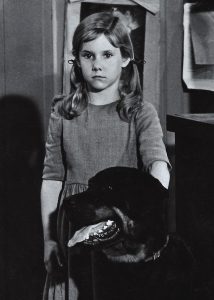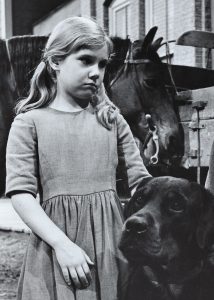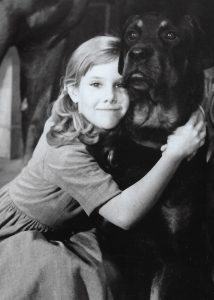 While filming an episode of “Gunsmoke” in 1968, there was a scene in which a dog was supposed to jump up and steal a sandwich from an actor’s hand. I was in the scene, and try as he might, the poor dog couldn’t get the stunt right. Time is money in the entertainment business, and the scene was taking a lot of time. Finally, the dog’s trainer hit the dog to make him “pay attention.” I was standing less than ten feet away. If I’d been an adult, I would have taken the dog and walked off the set, but I was only nine and couldn’t say anything. But I have these photos, taken on set as I witnessed an innocent animal being abused, to remind me of how I felt. It wasn’t the first time I’d seen an animal abused on a set, and it wouldn’t be the last.
While filming an episode of “Gunsmoke” in 1968, there was a scene in which a dog was supposed to jump up and steal a sandwich from an actor’s hand. I was in the scene, and try as he might, the poor dog couldn’t get the stunt right. Time is money in the entertainment business, and the scene was taking a lot of time. Finally, the dog’s trainer hit the dog to make him “pay attention.” I was standing less than ten feet away. If I’d been an adult, I would have taken the dog and walked off the set, but I was only nine and couldn’t say anything. But I have these photos, taken on set as I witnessed an innocent animal being abused, to remind me of how I felt. It wasn’t the first time I’d seen an animal abused on a set, and it wouldn’t be the last.
When animals are used for entertainment, they suffer—and the film and TV industries are no exception. Often torn away from their mothers as infants and subjected to lives of punishment and deprivation, animals used in movie and television productions have no control over their lives. They’re treated like props, often forced to perform confusing tricks on cue until they’re considered too old, too sick, or simply no longer profitable.
You’ve probably heard of American Humane, the organization which monitors the use of animals on film sets. They don’t do a very good job. First, there are only enough AH inspectors to monitor about one-third of film sets. Their priorities are also in question. The Los Angeles Times reported, in 2001, that the American Humane Film Unit “has been slow to criticize cases of animal mistreatment, yet quick to defend the big-budget studios it is supposed to police,” and that an examination of American Humane “also raises questions about the association’s effectiveness.” The article cites numerous cases of animals injured during filming which the American Humane overlooked. In 2013, The Hollywood Reporter ran a story which implicated American Humane in turning a blind eye to and underreporting incidents of animal abuse on television and movie sets. For example, during the filming of “The Hobbit: An Unexpected Journey,” 27 animals died. Nevertheless, the movie received a “no animals were harmed” disclaimer. During the filming of the movie “Life of Pi,” the tiger “King” nearly drowned in a pool, yet this incident was not reported outside of the American Humane organization.
 At off-set animal training compounds, living conditions are typically dismal, and abusive training techniques, including food deprivation, are commonly used to ensure that animals will perform on set in the fewest takes possible. Animals used in movies and on TV are trapped in the recurring role of “victim.”
At off-set animal training compounds, living conditions are typically dismal, and abusive training techniques, including food deprivation, are commonly used to ensure that animals will perform on set in the fewest takes possible. Animals used in movies and on TV are trapped in the recurring role of “victim.”
Using wild animals such as bears, snakes, big cats, monkeys, wolves, and elephants for entertainment is inherently cruel, and there is never a situation in which it’s acceptable to use them in a movie or on a TV show. No amount of training can ever completely override their natural instincts. In nature, most animals do everything that they can to avoid humans, but those used by Hollywood trainers are forced into close proximity with their captors and are also deprived of their families, their freedom, and everything else that’s natural and important to them.
While they may never get the life that they deserve in their natural habitat, wild animals used for movies and on TV shows can have the next best thing. Reputable sanctuaries across the country can offer them expert veterinary care, room to explore, seclusion, and freedom from the stress of transport and the chaos of film and TV sets. It’s the responsibility of Hollywood’s trainers to stop exploiting these animals and to relinquish them to reputable sanctuaries where they can have some semblance of a natural life. Filmmakers, too, have the responsibility never to use wild animals in their productions.
Domestic animals such as cats, dogs, horses, chickens, and cows have needs that are different from those of wild animals but are no safer from the deprivation, cruelty, and dangers of the movie and TV industries. Horses, for example, are historically among the animals most commonly injured and killed when used for movies and TV shows.
 An investigation into one of Hollywood’s most prominent animal suppliers documented that pigs were suffering without adequate veterinary care, cats were virtually starved for days, and dogs were kept outdoors in barren concrete kennels without bedding, even though temperatures dropped into the low 40s at night. A law enforcement raid on another company that supplied animals for Netflix, Disney+, AMC, and USA productions, found more than a dozen dogs in kennels stacked on top of one another in a garage.
An investigation into one of Hollywood’s most prominent animal suppliers documented that pigs were suffering without adequate veterinary care, cats were virtually starved for days, and dogs were kept outdoors in barren concrete kennels without bedding, even though temperatures dropped into the low 40s at night. A law enforcement raid on another company that supplied animals for Netflix, Disney+, AMC, and USA productions, found more than a dozen dogs in kennels stacked on top of one another in a garage.
In the movie business, cash is king—and animals’ well-being will always be compromised as long as profit margins and production deadlines rule the day. The living conditions and preproduction training methods that animals endure are often unregulated and unsupervised by the industry, which is why there is increasing demand for filmmakers to use computer-generated imagery or animatronics or, if the circumstances are right, cast their own companions, as Bradley Cooper did when he recruited his own dog for the new version of “A Star Is Born.” Filmmakers should always avoid commercial animal suppliers.
Fortunately, viewers are learning to see animals as individuals—not props—and filmmakers are taking note. Movies such as “The Lion King” and “The Jungle Book” brought Simba, Rafiki, Baloo, and Shere Khan to life without forcing a single animal to perform. Shows like “The Walking Dead” and “The Umbrella Academy” have incorporated stunningly realistic CGI of wild-animal characters who were at the center of the story arcs. CGI, animatronics, and other types of technology are paving the way for an enlightened approach to depicting animals in cinema—one in which nobody is whipped, caged, starved, or abandoned.
While some filmmakers and TV producers understand that animals aren’t ours to abuse for entertainment, many still need to be persuaded—and that’s where viewers come in. By avoiding shows and movies that use animals, the public can send a powerful message to Hollywood that profits won’t come without principles and that we expect them to keep animals out of their projects. I encourage compassionate viewers to take the fight to the industry and post their disapproval about the use of animals in a production on the social media pages of the director, the network, and the production company.

